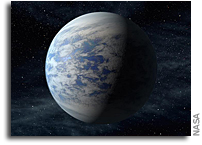A Low-order Model of Water Vapor, Clouds, and Thermal Emission for Tidally Locked Terrestrial Planets

We developed an idealized two-column model to investigate the climate of tidally locked terrestrial planets with Earth-like atmospheres in the habitable zone of M-dwarf stars.
The model is able to approximate the fundamental features of the climate obtained from three-dimensional (3D) atmospheric general circulation model (GCM) simulations. One important reason for the two-column model’s success is that it reproduces the high cloud albedo of the GCM simulations, which reduces the planet’s temperature and delays the onset of a runaway greenhouse state. The two-column model also clearly illustrates a secondary mechanism for determining the climate: the nightside acts as a “radiator fin” through which infrared energy can be lost to space easily. This radiator fin is maintained by a temperature inversion and dry air on the nightside, and plays a similar role to the subtropics on modern Earth. Since 1D radiative-convective models cannot capture the effects of the cloud albedo and radiator fin, they are systematically biased towards a narrower habitable zone.
We also show that cloud parameters are most important for determining the day–night thermal emission contrast in the two-column model, which decreases and eventually reverses as the stellar flux increases. This reversal is important because it could be detected by future extrasolar planet characterization missions, which would suggest that the planet has Earth-like water clouds and is potentially habitable.
Jun Yang, Dorian S. Abbot (Submitted on 4 Mar 2014) Comments: The Astrophysical Journal (in press), 14 pages, 11 figures, 1 table
Subjects: Earth and Planetary Astrophysics (astro-ph.EP)
Cite as: arXiv:1403.0905 [astro-ph.EP] (or arXiv:1403.0905v1 [astro-ph.EP] for this version)
Submission history From: Jun Yang [v1] Tue, 4 Mar 2014 19:17:42 GMT (314kb)








